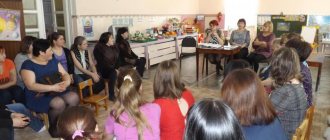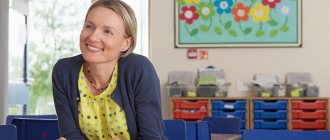Summary of the parent meeting: “Age characteristics of children 4–5 years old”
State budgetary preschool educational institution kindergarten No. 43, Kolpinsky district of St. Petersburg
Parent meeting summary:
"Age characteristics of children 4–5 years old."
Gr. “Teremok” teachers: Efimova A.I.; Grigorieva E. V.
Participants:
Educators, parents.
September 2017
Summary of the parent meeting:
“Age characteristics of children 4–5 years old” from 12.09.17
Gr. “Teremok” teachers: Efimova A.I.; Grigorieva E. V.
Goals:
expanding contact between teachers and parents; modeling prospects for interaction for the new academic year; improving the pedagogical culture of parents.
Tasks:
consider the age and individual characteristics of children 4-5 years old; introduce parents to the tasks and features of educational work, the tasks of the preschool institution for the new school year;
update the personal data of the families of the pupils; teach parents to observe the child, study him, see successes and failures, try to help him develop at his own pace; intensify work on children's speech development.
Participants:
educators and parents.
Event plan:
1. Introductory part.
2. Age and individual characteristics of children 4-5 years old.
3. Features of the educational process in the middle group.
4. Introducing parents to the goals and objectives of the preschool educational institution for the new school year.
5. Election of new members of the parent committee.
6. Briefly about miscellaneous things.
Progress of the event
Preparatory stage.
Preparation of an article about the age and individual characteristics of children 4-5 years old; extracts from the annual work plan of the preschool educational institution for the new academic year.
Organizational stage.
Parents come in and sit down randomly. Music plays to help relieve fatigue and encourage collaboration.
Introductory part.
Solemn music sounds.
Educator:
Good evening, dear parents! We are very glad to see you in our cozy group! We would like to congratulate you on the new academic year. Your children have grown up over the summer and moved to the middle group of kindergarten. Our children have grown up and become a year older. The children have learned a lot this year. They grew up, became stronger, and became more independent. They also became very inquisitive.
With the adoption of the Federal State Educational Standard, kindergarten became the initial stage of the Russian educational system. However, this does not mean that the kindergarten must teach the child to read and write by the time he enters school. The task of kindergarten is to develop the child’s desire to learn and learn new things. The educator is not a teacher; the child acquires all knowledge through play. Therefore, do not be surprised when your question: “What was your activity today?” you will receive the answer: “None.” It is while playing that we observe, and talk, and sculpt, and work.
We try to present any knowledge, even the most complex, to the child in a game where you can run around, hear a fairy tale, and reason. We try to create conditions so that every child feels emotionally comfortable, psychologically protected, and feels loved and unique. We make a lot of efforts to ensure that children can choose some corner of the group room to play. Of course, we cannot do without your help, dear parents. Children love you so much, are proud of you, imitate you in everything, and we share their feelings.
We hope that you and I will continue our journey through the land of knowledge just as fruitfully, and with the same wonderful teams we will approach our final destination - graduation from school.
At the beginning of our meeting, we would like to express our gratitude to the parents who actively took part in the life of the group - our parent committee. Thank you very much for your help. And also to all the parents who always came to our aid. It is with great pleasure that we present you with gratitude, and we hope that the other participants will also participate in the life of the group.
Educator:
Do you know, dear parents, what children aged 4-5 years are like?
Each child develops differently, each has its own path and pace of development.
The age of 4-5 years is rightly called middle preschool. Closer to the age of five, children begin to develop features characteristic of older preschoolers: some arbitrariness of mental processes, growth in cognitive interests and independence, attempts to explain the phenomena of life around them that interest them. Curiosity, the need for independence and activity, in turn, have a beneficial effect on the psyche and behavior. These features, for example, make it easier for a child of the fifth year of life to master the norms of his native language and speech functions.
At the same time, instability of mood, attention, emotional vulnerability, concreteness and imaginative thinking, passion for play and play situations bring children of the fifth year of life closer to younger preschoolers. And the expanding opportunities for raising and educating children at this age cannot be realized without knowledge and consideration of this duality of development. (V.V.Gerbova)
Features of the educational process in the middle group.
Dear parents!!! We kindly ask you to bring your beloved children to kindergarten on time, without delay. On Mondays and Thursdays at 8.00 - 8.10 morning exercises take place in the music room, I would like to see the children doing exercises, on other days exercises take place in a group. Many kids are late for breakfast and for classes. During classes, we will turn off the intercom, since the lesson is disrupted, the kids are distracted and the teacher is wasting time. If you are late and arrive during class, wait until class ends in the locker room. This year we will continue to engage in physical education and music, and for this the children need sports uniforms, shoes and Czech shoes.
Familiarizing parents with the goals and objectives of the preschool educational institution for the new school year.
Our kindergarten operates according to the program “From birth to school” edited by Vasilyeva.
This school year, children's development will also be carried out through the organization of all types of children's activities: gaming, communication, elementary labor, motor, cognitive-research, visual, constructive, musical, perception of fiction and folklore.
Organized activities for children are carried out in the following educational areas:
“Socio-communicative development”,
"Cognitive Development"
"Speech development"
"Artistic and aesthetic development"
"Physical development".
Election of a new parent committee.
Dear parents, to help organize all our joint events, we need to select a parent committee of the group. (5 people)
The selection of the parent committee takes place by counting votes and announcing the results. The personal composition of the group's parent committee is being discussed. The parent committee of the group is approved by direct vote.
In any team, understanding, good relationships, mutual assistance and mutual respect are very important. The conditions for harmonious relationships between children and parents, children and teachers, teachers and parents are the ability to give in to each other and mutual tolerance.
Final part
We wish you success, interesting discoveries, fun games and true friends! Only forward!
Memo for parents: “ What a 4-5 year old child should know and be able to do”
Speech development:
Correctly pronounce all the sounds of your native language;
Use nouns in speech that denote professions;
Use nouns with a general meaning: vegetables, fruits, berries, animals;
Agree words in gender, number, case;
Use sentences with homogeneous members;
Retell short literary texts, compose a story based on a plot picture, toy, objects;
Be able to answer questions based on the content of what you read;
Read short poems and nursery rhymes by heart;
Reproduce the content of works of art using the teacher’s questions.
Cognitive development:
Count within 5 (quantitative counting), answer the question “how much in total”;
Compare 2 groups of objects using counting;
Compare 5 objects of different lengths and heights, arranging them in ascending order by length and height;
Recognize and name a triangle, distinguish it from a circle and a square;
Distinguish and name parts of the day;
Determine the direction of movement from yourself (right, left, forward, backward, up, down);
Know your right and left hand;
Know and name the main parts of a building material (cube, block, plates);
Learn to analyze a building sample: identify the main parts and distinguish them by size and shape;
Be able to design from paper: bend a rectangular sheet of paper in half, matching the sides and corners;
Be able to identify the characteristics of objects (color, shape, size);
Determine the material from which the thing is made (wood, metal, paper, fabric);
Know furniture, clothing, dishes, some fruits, transport (cars, trains, planes, ships) in the immediate environment;
Distinguish and name parts of the animal and human body;
Recognize and name 3-4 trees, one shrub, 3-4 herbaceous plants;
Distinguish between 3-5 types of vegetables and fruits by taste, color, size and shape;
Know 2-3 types of wild berries, mushrooms (edible and inedible);
Name insects;
Have an idea about life in natural conditions of wild animals (hare, fox, bear, wolf, squirrel, hedgehog): how they move, what they eat, how they escape from enemies, adapt to life in winter conditions;
Have an idea about domestic animals and their cubs (about their behavior, movement, what they eat, what benefits they bring to people.
Artistic and aesthetic development:
Correctly convey in a drawing the shape, structure of objects, arrangement of parts, relationship in size;
Depict several objects in one drawing, placing them on the same line, throughout the entire sheet, connecting them with a single content;
Create patterns on a strip, square, circle, rosette, rhythmically arranging the elements;
Sculpt objects consisting of several parts;
Use techniques of pulling, smoothing, pressing, pressing and smearing;
Possess the skill of rational division of plasticine, use a stack in work;
Hold scissors correctly and use them;
Cut a square and a quadrangle diagonally, cut a circle from a square, an oval from a quadrangle, make oblique cuts;
Lay out and stick objects consisting of separate parts;
Make patterns from plant and geometric shapes on a strip, square, circle, rosette, alternate them by color, shape, size and stick them sequentially.
Social and communicative development:
Be able to negotiate with children what to play, who will be who in the game;
Use “polite” words;
Have an idea of your parents’ work;
Know the name of your homeland;
Know the name of the city, village where they live, street;
Observe the basic rules of organized behavior in kindergarten;
Follow the rules of conduct on the street and in transport;
Know the rules of the road (cross the street in special places, cross only when the traffic light is green);
Observe basic rules of behavior in nature (ways to safely interact with plants and animals, respect for the environment);
Have an idea of the importance of adult work;
Treats with care what is made by human hands.
Physical development:
Walk and run, coordinating the movements of the arms and legs;
Jump on 2 legs in place and moving forward, long jump from a place of at least 70 cm;
Take, hold, carry, put, roll, throw the ball from behind the head, from the chest;
Throw objects with the right and left hands at a distance of at least 5 meters, hit the ball on the ground (floor) at least 5 times in a row;
Climb a ladder - a stepladder, a gymnastic wall without missing the slats, climbing from one flight to another;
Crawl, crawl under a tight rope, lick over a log lying on the floor;
Form a column one at a time, in pairs, in a circle, in a line;
Ride a two-wheeled bicycle;
Orientate yourself in space.

